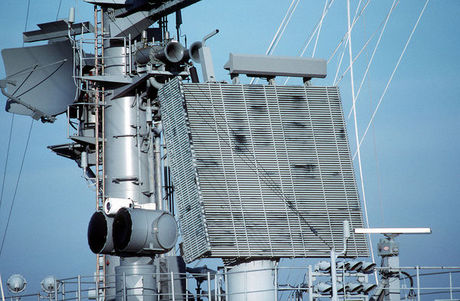Smaller and smarter antennas

Compact, powerful antennas for jamming or finding the source of a hostile signal.
When it comes to protecting the men and women of the armed forces, University of Wisconsin-Madison researcher Nader Behdad focuses his work on an obstacle most people wouldn’t associate with combat: the physical limitations of low-frequency antennas.
For decades, the military has sought to take greater advantage of low-frequency radio waves. The long wavelengths and propagation characteristics of radio waves in the 3 to 300 megahertz range enable long-distance communication and can penetrate or diffract around natural obstacles — making them useful in many military communications systems.
This frequency range is also a crucial tool in electronic warfare — jamming an enemy’s communications or, conversely, tracking down the source of a jamming signal in an electronic attack.
The laws of physics dictate that a conventional antenna has to get bigger as the wavelengths get longer. And when you’re dealing with 10- to 100-metre-long wavelengths, the antennas get far too bulky to lug into real-world electronic warfare situations.
Behdad, a UW-Madison professor of electrical and computer engineering, recently received a US$1.3 million grant from the US Office of Naval Research to tackle this problem on two different fronts.
Building from previous research successes, Behdad and his research group will explore how to make compact, powerful antennas for transmitting jamming signals in an electronic attack and how to develop better antennas for finding the source of a hostile signal.
“If you have a small platform and you want to put an antenna on it that works across this entire low-frequency band, this antenna can’t be a 10-metre-long antenna,” Behdad said. “If you have an unmanned aerial vehicle that’s flying, you don’t have that kind of real estate. Even on a ship — a ship is huge, but there are so many things on it — finding that kind of space would be a problem.”
On the transmission, or attack, side Behdad is working to develop a 1-metre antenna that can send high-power signals at frequencies as low as 3 megahertz.
What the military is seeking will push Behdad’s previous research — and the laws of physics — to the limit.
Behdad thinks he can achieve this short antenna with a combination of vacuum electronics, which can handle high-power transmissions, and the concept of non-Foster impedance matching, which essentially shows that antennas using negative impedance converting circuits can overcome some of the limitations that conventional circuits face.
The defence angle of the project also presents a problem of size. Again, convention says these antennas have to be large if the enemy is using low-frequency transmission and if the antenna needs to pick up that signal and determine where it’s coming from.
For several years, Behdad has been tackling this problem by developing biomimetic technology inspired by the Ormia ochracea, a tiny fly that achieves excellent directional hearing with two closely spaced ears on its thorax — which to an antenna engineer resembles a tiny antenna.
Behdad’s challenge is to adapt his previous successes to very small wavelengths. Success will mean military personnel can bring high-powered, low-frequency-range antennas into a greater variety of situations, gaining both a combat advantage and added safety.
“You can precisely figure out where your enemy is by listening to their communications and if they turn on any wireless device, you can figure out where they are,” Behdad said. “And the electronic attack antennas that we develop can be used to jam all of these communications.
“Similarly, you can jam their radars to make them blind. Finally, you can jam the signals used to remotely detonate improvised explosive devices to increase the warfighter’s safety.”
2025–26 Thought Leaders: Tim Karamitos
Tim Karamitos from Ericsson discusses the connectivity requirements of emergency services and...
2025–26 Thought Leaders: Ruth Tovo
Comms Connect panellist Ruth Tovo, from the South Australian SES, discusses the technical...
ARCIA update: celebrating excellence in our industry
The ARCIA Annual Gala Dinner and Excellence Awards took place during the same week as Comms...




